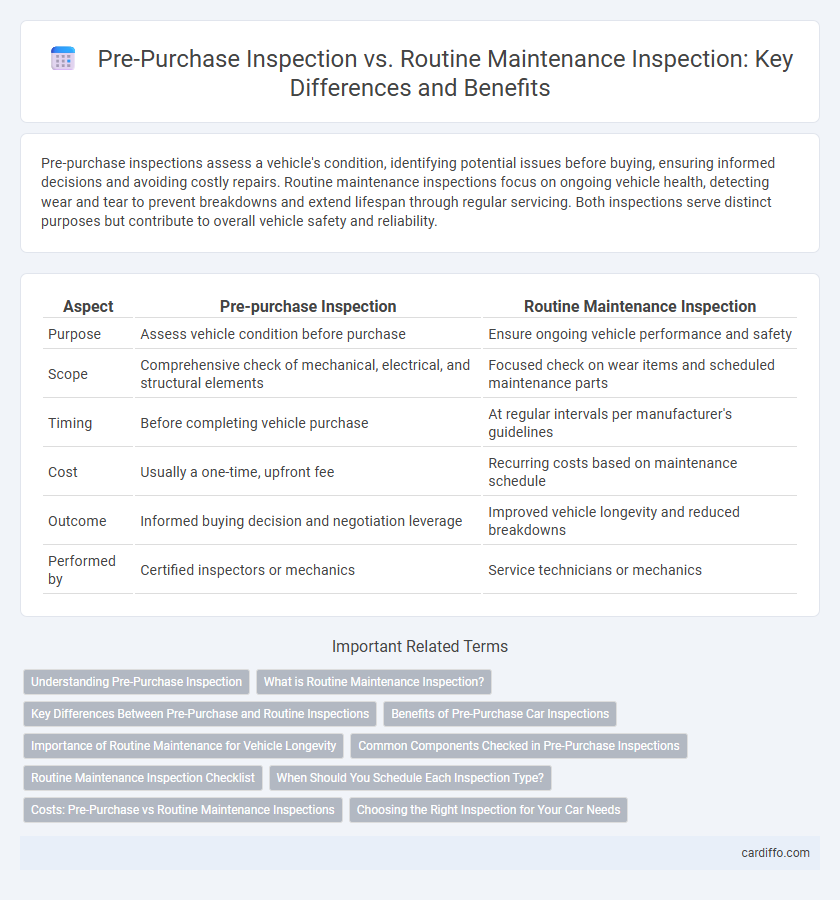Pre-purchase inspections assess a vehicle's condition, identifying potential issues before buying, ensuring informed decisions and avoiding costly repairs. Routine maintenance inspections focus on ongoing vehicle health, detecting wear and tear to prevent breakdowns and extend lifespan through regular servicing. Both inspections serve distinct purposes but contribute to overall vehicle safety and reliability.
Table of Comparison
| Aspect | Pre-purchase Inspection | Routine Maintenance Inspection |
|---|---|---|
| Purpose | Assess vehicle condition before purchase | Ensure ongoing vehicle performance and safety |
| Scope | Comprehensive check of mechanical, electrical, and structural elements | Focused check on wear items and scheduled maintenance parts |
| Timing | Before completing vehicle purchase | At regular intervals per manufacturer's guidelines |
| Cost | Usually a one-time, upfront fee | Recurring costs based on maintenance schedule |
| Outcome | Informed buying decision and negotiation leverage | Improved vehicle longevity and reduced breakdowns |
| Performed by | Certified inspectors or mechanics | Service technicians or mechanics |
Understanding Pre-Purchase Inspection
Pre-purchase inspection involves a comprehensive assessment of a vehicle's condition before finalizing a purchase, identifying potential issues that could affect safety, performance, and resale value. It differs from routine maintenance inspections, which focus on regular upkeep tasks such as oil changes, brake checks, and fluid levels to ensure ongoing vehicle reliability. Understanding pre-purchase inspections helps buyers make informed decisions by uncovering hidden defects and avoiding costly repairs after the sale.
What is Routine Maintenance Inspection?
Routine maintenance inspection involves regular, scheduled evaluations of a vehicle or equipment to ensure optimal performance and safety. It typically includes checking fluid levels, brake functionality, tire condition, and engine components to detect wear or potential issues early. This proactive approach helps prevent costly repairs and extends the lifespan of the asset.
Key Differences Between Pre-Purchase and Routine Inspections
Pre-purchase inspections focus on evaluating a vehicle's overall condition before finalizing a sale, emphasizing defect detection, accident history, and market value assessment. Routine maintenance inspections prioritize ongoing vehicle performance, safety, and the prevention of mechanical failures through regular checkups based on mileage or time intervals. Key differences include the inspection's purpose, timing, and scope, with pre-purchase inspections being comprehensive and condition-focused, while routine inspections are preventive and maintenance-oriented.
Benefits of Pre-Purchase Car Inspections
Pre-purchase car inspections provide a detailed assessment of a vehicle's condition before ownership transfer, helping buyers avoid costly repairs and uncover hidden defects or accident history. This inspection offers critical insights into engine health, structural integrity, and mechanical functionality, ensuring an informed purchasing decision. Unlike routine maintenance inspections that focus on ongoing vehicle upkeep, pre-purchase inspections emphasize risk mitigation and value assurance for potential buyers.
Importance of Routine Maintenance for Vehicle Longevity
Routine maintenance inspections play a crucial role in extending vehicle longevity by identifying and addressing wear and tear before major issues develop. Regular checks of critical components such as brakes, fluids, tires, and engine parts prevent costly repairs and improve overall safety. Consistent upkeep through routine maintenance inspections ensures optimal performance and maximizes the vehicle's operational lifespan.
Common Components Checked in Pre-Purchase Inspections
Pre-purchase inspections typically focus on critical components such as the engine, transmission, brakes, suspension system, and overall structural integrity to ensure the vehicle's condition matches the seller's claims. Inspectors also assess fluid levels and look for signs of leaks or corrosion that could indicate underlying issues, which are less emphasized in routine maintenance. In contrast, routine maintenance inspections prioritize wear and tear, replacing filters, oil changes, and tire condition rather than an extensive evaluation of all mechanical and structural elements.
Routine Maintenance Inspection Checklist
A Routine Maintenance Inspection Checklist ensures ongoing vehicle reliability by systematically evaluating key components such as engine oil levels, brake performance, tire condition, and fluid levels to detect wear and prevent breakdowns. Unlike Pre-purchase Inspections, which assess overall vehicle condition before buying, Routine Maintenance Inspections focus on scheduled upkeep according to manufacturer specifications. This proactive approach reduces repair costs and extends vehicle lifespan through timely identification of potential issues.
When Should You Schedule Each Inspection Type?
Schedule a pre-purchase inspection before finalizing any vehicle purchase to assess its condition and uncover potential issues. Routine maintenance inspections should be performed regularly, typically every 5,000 to 10,000 miles or as recommended by the manufacturer, to ensure ongoing vehicle performance and safety. Prioritizing timely inspections extends vehicle lifespan and minimizes costly repairs.
Costs: Pre-Purchase vs Routine Maintenance Inspections
Pre-purchase inspections typically incur higher costs due to their comprehensive evaluation of a vehicle's condition before purchase, often ranging from $100 to $300. Routine maintenance inspections are generally more affordable, averaging between $50 and $150, as they focus on regular upkeep and identifying potential issues. The investment in a pre-purchase inspection can prevent costly repairs later, while routine inspections help maintain vehicle performance and longevity over time.
Choosing the Right Inspection for Your Car Needs
Pre-purchase inspections provide an in-depth evaluation of a vehicle's condition before buying, identifying hidden issues and potential repair costs, whereas routine maintenance inspections focus on the ongoing upkeep and performance of your current car to prevent breakdowns. Selecting the right inspection depends on your specific needs: invest in a pre-purchase inspection when considering a used vehicle to ensure a sound investment, and schedule routine maintenance inspections regularly to maintain your car's reliability and extend its lifespan. Professional mechanics use diagnostic tools and check critical systems like brakes, engine, and suspension in both inspection types to deliver accurate assessments.
Pre-purchase inspection vs routine maintenance inspection Infographic

 cardiffo.com
cardiffo.com